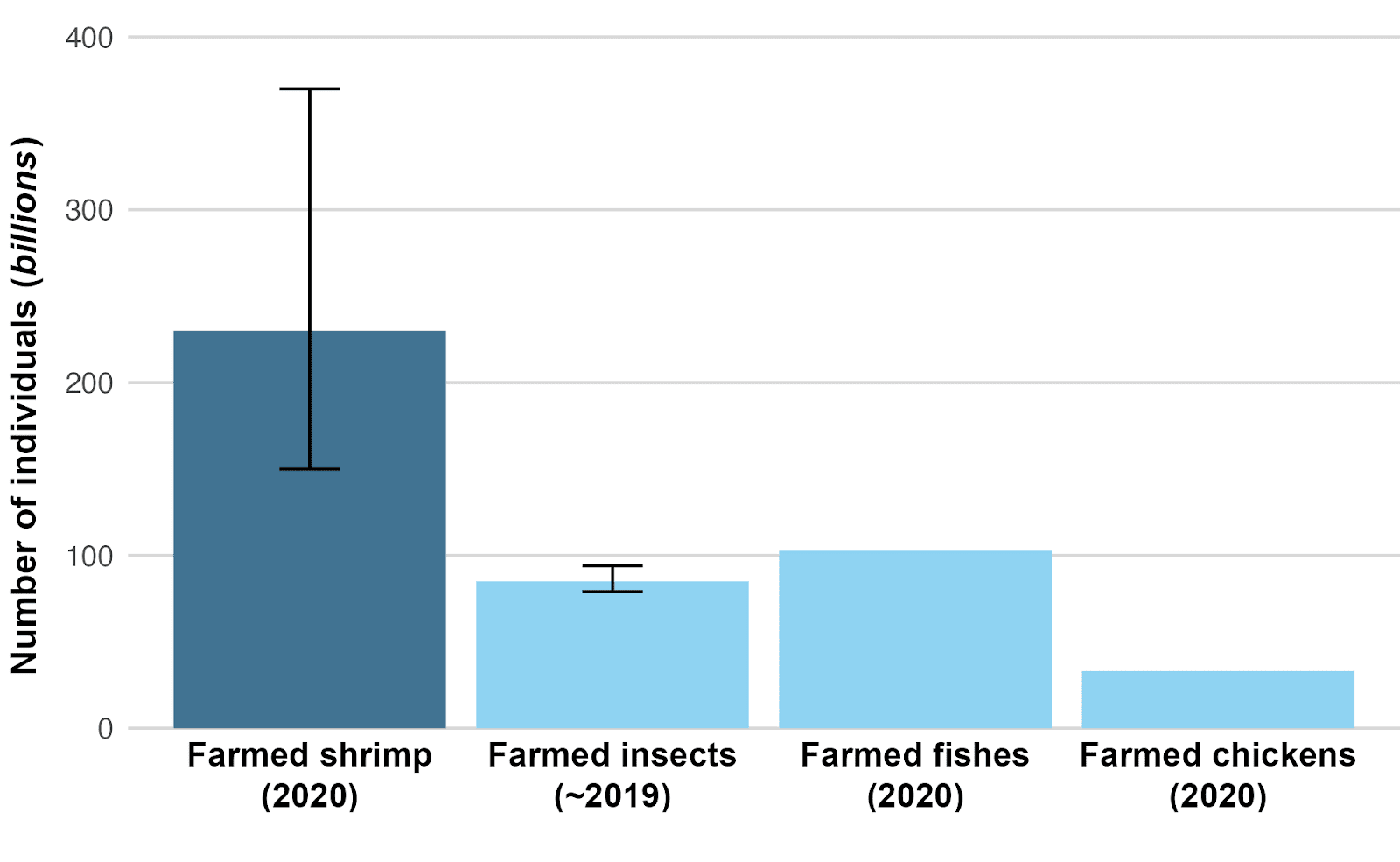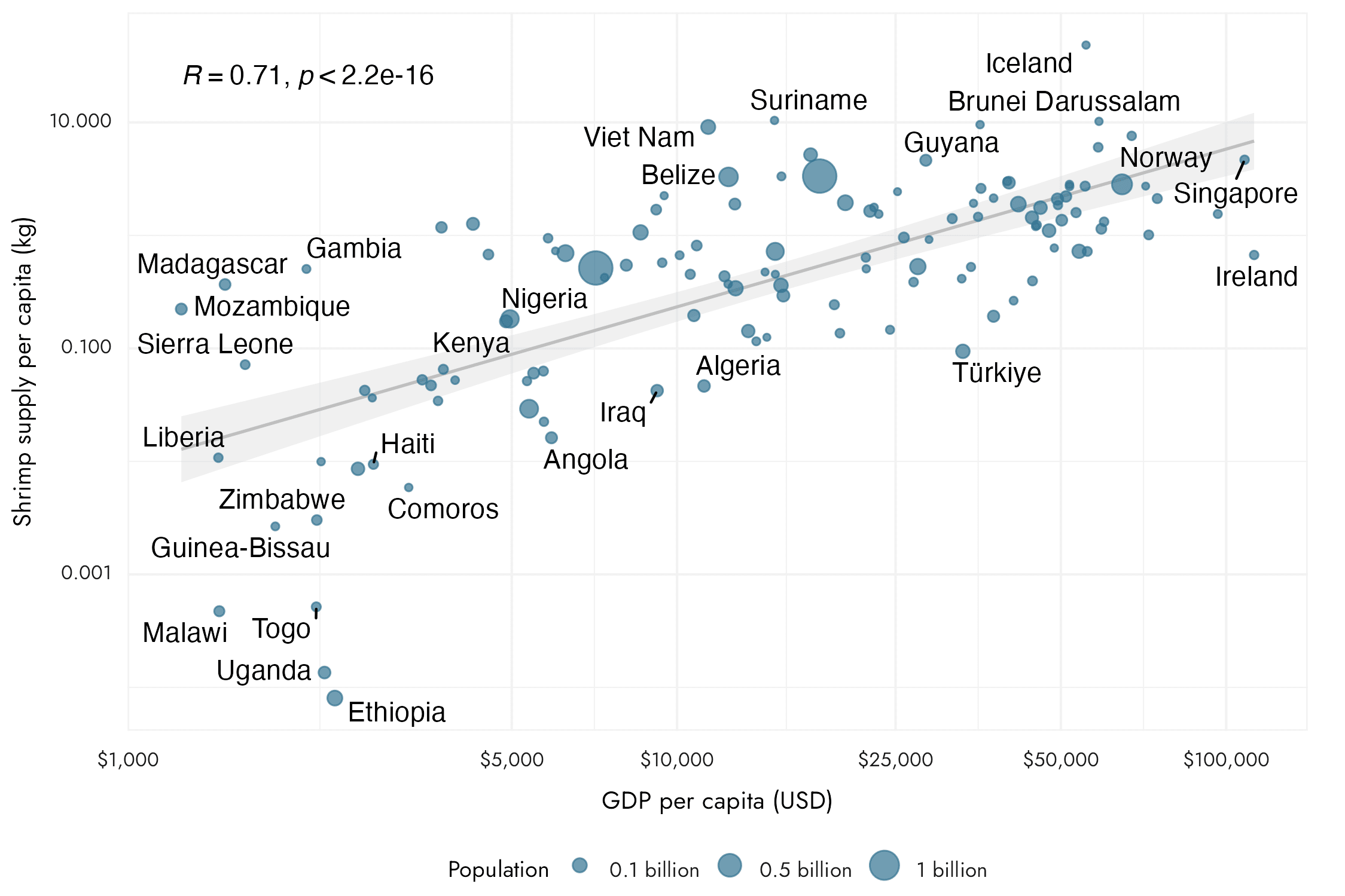Who this report is for and how to access it
Only a handful of animal advocacy organizations have programs aimed specifically at preventing the exploitation of farmed shrimp. We wrote this report to provide practical guidance about how to help farmed shrimp. This public summary provides an overview of the current state of shrimp farming and potential paths forward. For a deeper dive, the full 70+ page report offers concrete, strategic recommendations and more detailed insights. The full report will be most useful for animal advocacy groups, funders, and those interested in how best to help shrimp. If you would like access to the full report, please complete this Google form.
Summary
Shrimp production: industry numbers, trends, and practices
- Shrimp aquaculture can be bad for animals, humans, and the environment
- At any given time, shrimp are the most numerous farmed animal (Figure 1)

- Animals like fish are caught and farmed to feed farmed shrimp, increasing the negative welfare effects of shrimp farming
- Farmed insects could also become an important shrimp feed
- The shrimp farming industry contributes to carbon emissions, antimicrobial resistance, food safety, and human labor and rights issues
- Production and consumption are concentrated in a handful of countries
- China, Ecuador, Viet Nam, India and Indonesia are top producer countries
- China is also a top importer, alongside the US, Japan, Spain, and France
- Demand for shrimp is increasing
- As the world population grows, so will shrimp consumption
- Economic growth also correlates with increased shrimp consumption (Figure 2)

- To meet demand, the industry is adopting more intensive practices
- Intensive farms use higher stocking densities, presenting new welfare threats
- Because the most intensive farms can be located inland and in greenhouses, farms could open in new countries that are otherwise too cold for aquaculture
- Vegan or diet-change advocacy on only environmental grounds could harm shrimp welfare in the long-term by causing people to shift from eating larger-bodied animals, like cattle, to eating shrimp, which would increase the overall number of farmed animals
Shrimp advocacy: current state, opportunities, and bottlenecks
- In the past few years, a handful of organizations have worked to reduce shrimp suffering
- Policy advocacy led to the inclusion of decapod crustaceans in the UK Animal Welfare (Sentience) Act 2022, which legally recognized them as sentient
- Retailer outreach has gained traction in the UK and Netherlands, indicating that companies are increasingly aware of growing public concern for crustacean welfare
- At least six retailers in the UK and Netherlands have implemented some of the world’s first crustacean welfare policies
- For shrimp, all of these policies commit to eliminating eyestalk ablation and half also plan to improve slaughter practices by electrically stunning all shrimp in their supply chains
- Groups are working with producers to improve their practices, resulting in several agreements to electrically stun shrimp prior to slaughter, protocols to measure on-farm welfare, and training for farmers to monitor and improve their pond conditions
- Some welfare standards are now included in certification schemes, with several prohibiting eyestalk ablation
- More progress can be made. Advocates could work to:
- Add shrimp welfare provisions, such as banning eyestalk ablation and enforcing humane slaughter, to aquaculture certification schemes (similar to certifying eggs as "free-range")
- Encourage more retailers, especially in countries that import a lot of shrimp, to source from higher-welfare farms (similar to movement-wide efforts on cage-free eggs)—for now, this means farms that do not source from eyestalk-ablated broodstock and that humanely slaughter shrimp
- Advocate for shrimp to be protected under animal welfare legislation—only a handful of countries have any mention of decapod crustaceans in animal welfare protections, and even fewer specifically apply to shrimp
- Develop alternative foods that taste like shrimp to help reduce demand for farmed shrimp
- To meaningfully help farmed shrimp, key bottlenecks need to be overcome:
- A small scientific evidence base about shrimp’s needs means several questions remain unanswered, like what level of crowding impedes their welfare and what temperatures and enrichments they prefer
- The biggest constraint to improving farmed shrimp lives right now is funding for the movement. Supporting shrimp work right now could provide much-needed stability to this nascent work and significantly increase the chances of the movement gaining critical momentum
- We believe that supporting shrimp welfare is currently one of the largest opportunities for animal funders to have the greatest marginal impact
- Despite these constraints, many options for helping shrimp remain on the table. Advocates and funders should apply the precautionary principle and act on existing evidence to help shrimp sooner rather than later.
If you would like to access the full report, which includes concrete recommendations, please request access using this Google form. Requests will usually be evaluated within 24 hours.
If you have any questions or would like further clarification on specific points, please feel free to reach out to hannah@rethinkpriorities.org. Additionally, if you're interested in a private presentation tailored to your organization, please let us know by indicating your interest here.

FWIW, given the moral ambiguity of fishing, the catch of wild animals for (shrimp) feed could be good overall for wild (aquatic) animals, instead of bad.
This and the effects of shrimp feed (crop) production on terrestrial wild animals make me somewhat inclined not to try to shift shrimp consumption towards plant-based food (substitutes or general reduction). My best guess is that crop production tends to decrease wild arthropod populations (Attwood et al., 2008, tables 3 and 4; Newbold et al., 2015), and animal products tend to decrease wild terrestrial arthropod populations more than plant-based products due to greater land use for crops per calorie or kg of protein (e.g. Our World in Data, based on Poore & Nemecek, 2018), so shifting towards plant-based would be bad for wild terrestrial arthropods, if they have bad lives or you're suffering-focused.
However, farmed shrimp/prawns may use less land than plant-based foods per gram of protein, so maybe shifting away from them would be good by reducing wild terrestrial arthropod populations, too. This is something I'd like to look more into. I imagine land use for shrimp/prawns is only so low according to these estimates because they're assuming a high rate of wild aquatic ingredients (whose impacts are morally ambiguous!). You probably can't get lower land use than tofu per kg of protein by feeding shrimp almost entirely soy and grains, because of higher losses in feed conversion than in soy processing into tofu (and tofu having similar or less land use than other feed ingredients per kg of protein).
Thanks for sharing.
I would be curious to know why you have decided to keep the full report private. Such that you keep track of who uses it, thus helping you assess its impact?
Hello.
Does this include wild shrimp?
Nitpick. I think it would be good to include "Logarithm of" in the titles of the axes, or just keep the titles you used, but display values in kg and $ instead of their logarithms, and have the axes in a logarithmic instead of linear scale.
Hi Vasco,
This graph does include wild shrimp. I've made the change to the axes you suggested and updated the figure caption to note that wild shrimp are included. Thanks for your suggestions!